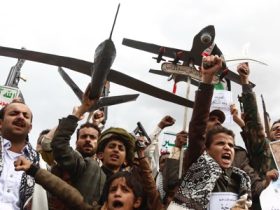A month before the Hague summit, NATO’s top military officer said he has no indication yet that the United States will withdraw forces committed to the alliance’s defense plans and shift them to the Indo-Pacific.
Still, Adm. Giuseppe Dragone — who chairs NATO’s top board of military officers — argued that the alliance needs to prepare for the U.S. to direct its attention away from the continent.
“A key issue would be [to] plan that in advance,” Dragone said of any changes in U.S. military posture. “That would give the alliance the capability to reorient and to rebalance.”
The admiral, who took his office in January, spoke while visiting Washington with other NATO leaders to meet with Pentagon officials, including Vice Chairman of the Joint Chiefs of Staff Adm. Christopher Grady.
In the last several months, the Pentagon has emphasized the threat of China at the expense of the one posed by Russia, now more than three years into its invasion of Ukraine.
A provisional U.S. defense strategy, portions of which leaked in March, drew heavily from a Heritage Foundation report written by a now-top Pentagon policy official. The document argued that the U.S. should identify its forces committed to NATO defense plans that would also help deter an invasion of Taiwan. The Pentagon would then shift those units closer to Asia, forcing European countries to close the gap.
Dragone said he hadn’t yet heard that the Pentagon was following through on those plans but said European countries could eventually backfill the loss of some U.S. forces on the continent — including air defenses, electronic warfare, strategic airlift and drones.
Since the war in Ukraine, NATO countries have increased defense spending and now have 22 of the 32 member states meeting the 2% of GDP floor. U.S. President Donald Trump has repeatedly said that rate isn’t enough, instead calling for 5%.
NATO Secretary General Mark Rutte has reportedly discussed a revised proposal of 3.5% spent on defense with 1.5% dedicated to other security-related measures, to be introduced at the Hague Summit in June. Dragone confirmed that share is being discussed, but was less specific on the timeline to implement it or what the added money should fund.
“The end state will be 3.5 plus 1.5, whatever they decide, but the way they will reach it should be a national responsibility,” Dragone said. “I think that NATO should be flexible and try to be realistic, even if pushy.”
Dragone’s home country of Italy is one of 10 NATO members that doesn’t meet the 2% threshold, instead spending 1.49% on GDP on defense in 2024. Prime Minister Georgia Meloni said in April that Italy would meet the required target this year.
These increases must also keep pace with the military buildup Russia has conducted during the war in Ukraine, reorienting the economy to sustain enormous losses in equipment and personnel.
Dragone said that Russia continues to lose somewhere between 1,000 to 1,200 troops a day on the front line but will keep reconstituting its force even if a peace deal is reached.
At a minimum, he said, Russia would seek to restore the military strength it had before the war in 2022, even though it failed to reach its goals when launching the invasion. At the fastest, Russia could reach that strength in three years, though a more realistic timeline is likely five to seven years, Dragone said.
Noah Robertson is the Pentagon reporter at Defense News. He previously covered national security for the Christian Science Monitor. He holds a bachelor’s degree in English and government from the College of William & Mary in his hometown of Williamsburg, Virginia.
Read the full article here








Leave a Reply